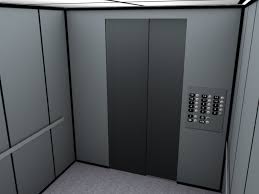

Many of us use them several times a day without really noticing. And yet the way we are in lifts, or elevators as they are known in the US, reveals a hidden anxiety.
And yet the way we are in lifts, or elevators as they are known in the US, reveals a hidden anxiety.
Passengers seem to know instinctively how to arrange themselves in an elevator. With each additional passenger, the bodies shift, going into the open spaces.
With each additional passenger, the bodies shift, going into the open spaces.
On your own, you can do whatever you want -- it's your own little box. If there are two of you, you take different corners, creating the greatest distance.
If there are two of you, you take different corners, creating the greatest distance. When a third person enters, you will unconsciously form a triangle.
When a third person enters, you will unconsciously form a triangle. And when there is a fourth person it's a square, with someone in every corner.
And when there is a fourth person it's a square, with someone in every corner. A fifth person is probably going to have to stand in the middle.
A fifth person is probably going to have to stand in the middle.
Why are we so awkward in lifts?
"You don't have enough space," says Professor Babette Renneberg, a clinical psychologist at the Free University of Berlin. "Usually when we meet other people we have about an arm's length of distance between us.
"Usually when we meet other people we have about an arm's length of distance between us. And that's not possible in most elevators, so it's a very unusual setting.
And that's not possible in most elevators, so it's a very unusual setting. It's unnatural."
It's unnatural."
But perhaps there is more to it than just social awkwardness.
"In the back of our minds we are a little anxious," says Nick White, an office in New York who was unfortunate enough to be trapped in a lift for 41 hours. "We don't like to be locked into a place.
"We don't like to be locked into a place. We want to get out of the elevator as soon as possible, you know, it's a frightening place to be."
We want to get out of the elevator as soon as possible, you know, it's a frightening place to be."
During his terrible experience, he began to think of another enclosed space -- a tomb.
Dr. Lee Gray agrees that a sense of disempowerment is the main cause of life anxiety.
"You're in a machine that's moving, over which you have no control. You cannot see the elevator engine; you don't know how it's working," he says.
You cannot see the elevator engine; you don't know how it's working," he says.

联系我们 | 意见反馈 | 商标声明 | 站点地图
版权所有:广州奥文信息科技有限公司 Copyright © 2011 All Rights Reserved.
粤ICP备: 11095722号 增值电信业务经营许可证: 粤B2-20120156 